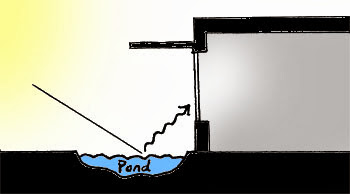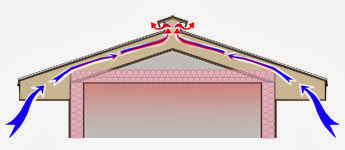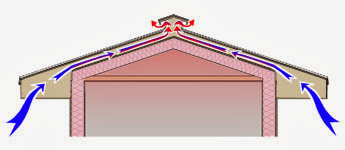
Shading Windows |
The amount of energy spent on heating and cooling homes can be severely reduced by using simple design techniques. Building materials and structural design greatly impact the temperature inside a space. A building can use the power of the sun to heat or cool itself, with techniques that were developed over thousands of years in distant parts of the world. These techniques are cheap, saves money, and helps the environment.
|
|
Overhangs – Size roof overhangs so that the summer sun is blocked but so that the lower winter sun is let through. Consider the height of the sun in these seasons for the length of your roof eaves.
The height of the sun in summer and winter depends on your elevation. This direct sunlight will heat spaces considerably in the winter. But unless you live in a very cold climate, you don’t want this heat gain in the summer. |  |
 |
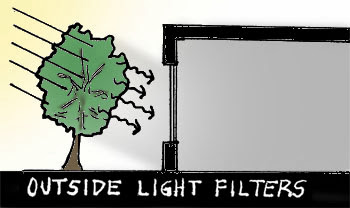 |
Outside Objects Shade Sun – Outside elements such as mountains and structures help block the sun. Trees and bushes are excellent for filtering sunlight.
Deciduous trees drop their leaves in the winter, allowing sun in the winter but blocking sun in the summer.
Thermal Mass
The best way to cool a building is to build with thick stone or masonry. Castles and caves have massive walls that soak up heat like a sponge. As the temperature cools down in the night time this heat gets released, mitigating the overall temperature.
The sizing of brick, masonry, or stone should be carefully considered so not too much heat gets sucked out and the house becomes drafty in the winter. In places that see little extreme cold temperatures, a lot of thermal mass should be used. In places that see little extreme hot temperatures, little or no thermal mass should be used. Thick insulating material such as fabric or polyurethane panels would be better.
The heat stack effect literally sucks heat out of the building and up into the courtyard. Conversely, cold regions should not have courtyards and the building’s shape should be as compact as possible. A cube-shaped building will conserve energy much better than a long flat building.
Solar Towers For Natural Drafts & Heating
|
Heat Stack – Many homes have tall front entrances. They naturally provide cooler temperatures.
If the insulation at this tall space is thinner than everywhere else, sunlight radiation will heat up the ceiling. As this hot air vents through an upper window it will suck up cooler air from below, creating a natural draft and cooling the entire house. This is known as the stack effect. But what about the winter? Even with the upper window closed, this warmer air will suck up air and create an unwanted draft. |  |
|
The best thing to do is isolate this solar tower to its own room that can be opened or closed with a door. It can provide a cooling draft in the summer and be isolated away behind closed doors in the winter.
Solar Chimney – A very effective and low-cost device that rarely gets used is the solar chimney. It is particularly effective for creating a draft in humid, hot climates that have very few options for cooling. | 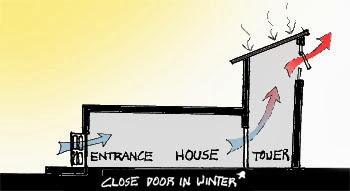 |
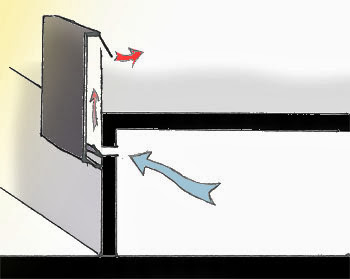 |
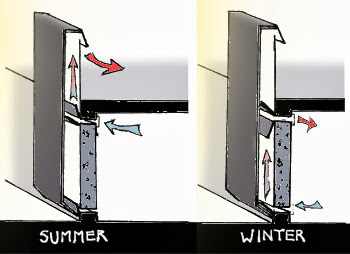 |
A long flat chimney faces the sun and is painted black so that the air inside heats up. This air vents out the top and sucks out the air below.
The important thing to make this work is to make these chimneys long and thin. The important principles behind the stack effect is area of air flow and height of the chimney.
For a 7ft heigh chimney, the air space in the chimney 6″ wide. Inlet and outlet vents should only be 2″ heigh, the upper vent slightly less, to prevent backdrafting.
| It could also heat the house in the winter. Close off the upper chimney with a damper and allow the heated air to enter back into the room. A popular variation of this is the soda can heater. Air flows from can to can in little pockets, which gives it a chance to really heat up before it vents out of the top.
In temperate climates it is also helpful for the building’s structural wall to be thermal mass. This trombe wall mitigates heat to cool down in the summer and heat in the winter. In more extreme climates, this wall should well insulated and dampers tightly sealed. Close all dampers at night. If possible, angle the chimney toward the sun. The more directly the sun hits it the better it can heat up. The chimney should be metal, painted black, with a clear insulating glazing around it. Also, put some weep holes at the bottom so that condensation doesn’t mold up inside. |
Cold Roof vs. Warm Roof
Solar Water Heating
Most solar water heaters use heat exchangers to absorb sunlight with glycol and transfer the warmth to water. But glycol is difficult to work with, as it is very viscous, easily leaks and contaminates, and turns into dangerous acid if it oxidizes with aluminum and other metals.
A very cheap and easy way to use the sun to heat incoming water is to simply run the pipes outdoors through insulated glass. Copper pipes zig zag through an insulated box with a glass top and black bottom, maintaining the same water pressure. These pipes are painted black to absorb the heat that gets trapped in the box.
|
Evacuated tube collectors use a vaccum between the pipe and a tube around it to insulate heat from escaping. But a much cheaper way is to stack plastic soda bottles, trapping air pockets as with the soda can solar chimney. Aluminum cans can be cut into broad arcs and placed at the bottom to reflect heat to the pipes.
The amount of heat that can be absorbed when the sun is shining is incredible, so include a pressure release valve. Drain the pipes in the winter and bypass the water directly to the water heater when it gets too cold outside to be effective. | 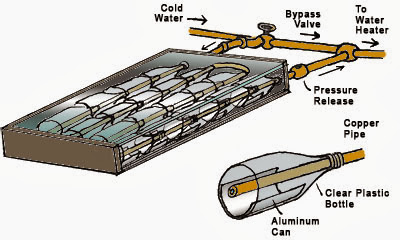 |
By supplementing a water heater with a solar heated water first, a lot less energy is needed to get the water hot. There are all kinds of solar water heaters available and professional services to install a well-running system. Energy savings makes it a very popular solution all over the world, although it isn’t very popular at all in the United States because its average payback period is 21 years.
© Benjamin Blankenbehler 2013


